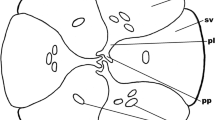Summary
InCabomba caroliniana the carpels arise as appendicular organs over the floral apex whereas the ovules arise on the adaxial surface of the carpel primordium. The growth of the ovule is traced from a developmental viewpoint. The nucellar tissue grows in height due to the presence of a characteristic meristem. We designate this as thebasal meristem.
Megasporogenesis is described and the embryo-sac development conforms to thePolygonum type.
Similar content being viewed by others
References
Godavari, H. R. .. “Studies in the embryology of Nymphaeaceae,”M.Sc. Thesis, University of Delhi, 1956.
Khanna, Pushpa.. “Some interesting observations inEuryale ferox Salisb.,”Curr. Sci., 1964a,33, 152–53.
Khanna, Pushpa.. “Morphological and embryological studies in the Nymphaeaceae. I.Euryale ferox.”Proc. Indian Acad. Sci., 1964b,59 B, 237–248.
Moseley, M. F. Jr... “Morphological studies of the Nymphaeaceae. II. The flower ofNymphaea,”Bot. Gaz., 1961,122, 233–59.
Sass, J. E...Botanical Microtechnique, 2nd Ed., Iowa State College Press, Iowa, 1951.
Schnarf, K. ..Vergleichende Embryologie der Angiospermen, Berlin, 1931.
Author information
Authors and Affiliations
Additional information
Communicated by Professor T. S. Sadasivan,f.a.sc.
Rights and permissions
About this article
Cite this article
Ramji, M.V., Padmanabhan, D. Developmental studies onCabomba caroliniana gray. Proc. Indian Acad. Sci. 62, 215–223 (1965). https://doi.org/10.1007/BF03051609
Received:
Issue Date:
DOI: https://doi.org/10.1007/BF03051609




